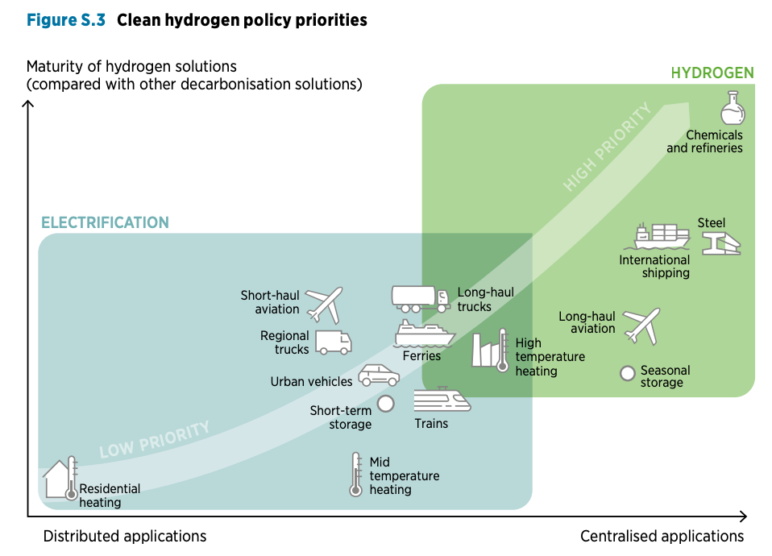“We’re very bullish on renewable hydrogen,” hyped a representative from NW Natural, Oregon’s largest gas utility, when testifying in support of a 2021 hydrogen bill in Oregon. Hydrogen enthusiasm is at an all-time high, with the recent passage of multi-billion dollar subsidies by federal policy makers and major oil and gas corporations backing hydrogen projects, including Northwest utilities. Proponents of the fuel envision a future in which hydrogen—and specifically a strain of it being marketed as “renewable hydrogen”—heats homes and businesses, powers trains and cars, and balances the electric grid.
Renewable hydrogen, also known as green hydrogen, does have its place in a climate-friendly future, namely in cleaning up hard-to-decarbonize sectors like steelmaking, long-haul shipping, and aviation, and in generating electricity during windless, cloudy periods. Plus, existing hydrogen consumers, like petrochemical refineries, metallurgical industries, and ammonia and fertilizer manufacturers, could reduce their emissions by switching from hydrogen produced by fossil fuels to hydrogen produced from renewable electricity (see our primer on the different types of hydrogen).
But natural gas utilities, including those in Cascadia, have their eyes on a much bigger prize: pumping hydrogen through the natural gas pipeline system to heat buildings—and raking in the accompanying profits. Unfortunately, hydrogen is not the solution these fossil fuel corporations make it out to be, nor should it be their next cash cow. It merely delays the much-needed shift to electrification, holding ratepayers subject to more expensive fossil fuel infrastructure and a more dangerous and less efficient fuel—all while slowing progress toward the region’s decarbonization goals. Lawmakers and regulators should beware the industry’s hype as they weigh hydrogen’s permitted uses.
Hydrogen for home heating scores low on efficacy, cost, efficiency, and safety
Despite being touted by natural gas utilities as the best path to clean home heating, hydrogen is much less effective at decarbonizing buildings than is electricity. Only small volumes of hydrogen, perhaps up to a ratio of 20 percent hydrogen to 80 percent natural gas, can safely be injected into existing gas pipelines. But a 20 percent blend of hydrogen only shaves off around 7 percent of the combustion emissions of a system running on 100 percent natural gas. Put in context, in Washington, for example, buildings’ emissions will need to decrease 96 percent by 2050 for the state to meet its legislated decarbonization commitments.
What’s more, blending higher ratios of hydrogen into existing natural gas infrastructure to achieve greater emissions reductions could cost billions. Most gas distribution pipelines would need to be replaced or extensively retrofitted to safely accommodate the new fuel, since at higher volumes than 20 percent, hydrogen can degrade pipelines. Plus, higher ratios of hydrogen are incompatible with existing appliances like stoves and water heaters, meaning consumers would also need to buy new hydrogen-compatible appliances. These replacement requirements and associated costs are why major studies for the Northwest conclude that wide-spread electrification is the least expensive pathway to decarbonize building.
Plus, hydrogen is less efficient than electricity at heating homes. A 2021 study found that heating a home with green hydrogen has an efficiency of around 46 percent.1 Heating a home with an electric air-source heat pump, on the other hand, has almost six times that efficiency, at around 270 percent. Yes, hydrogen could provide carbon-free heat in a home, but heating with hydrogen demands nearly six times as much renewable electricity as does an electric heat pump. Heating with hydrogen, in other words, is like drying your dishes with a blow torch.
Lastly, hydrogen introduces serious safety concerns. Hydrogen ignites more easily than natural gas. Flammability, coupled with pipeline integrity vulnerabilities from too-high blends of hydrogen, is a recipe for catastrophe. Serious injuries would increase nearly four-fold if hydrogen wholly replaced natural gas, according to a 2021 study conducted for the UK government. Even at modest concentrations of hydrogen in a natural gas pipeline, scientists are raising red flags. “The overall risk is significantly increased for all hydrogen levels, and it becomes severe at hydrogen levels above 20 percent,” according to an analysis by the US Department of Energy’s National Renewable Energy Lab in Golden, Colorado. Hydrogen is also invisible and odorless, and thus far, no odorants have been identified that could be applied to hydrogen to detect leaks.
Given the challenges around efficiency, cost, effectiveness, and safety, it is little surprise that home heating is the lowest priority among 15 possible hydrogen uses identified by the International Renewable Energy Agency, as shown in the graphic below.

Source: IRENA (2022), Geopolitics of the Energy Transformation: The Hydrogen Factor,
International Renewable Energy Agency, Abu Dhabi.
Cascadian utilities are rushing to bet big on hydrogen; Lawmakers and regulators beware
Hydrogen heating in Cascadia isn’t a far-off aspiration; it’s an active business plan by regional gas utilities. Both Puget Sound Energy (PSE) and NW Natural, Washington and Oregon’s largest gas utilities respectively, have already entered into project commitments to pump hydrogen through their natural gas distribution pipelines. NW Natural envisions injecting hydrogen into its natural gas pipeline for “transportation, heating, manufacturing and other processes” and told its investors that it intends to meet its carbon neutrality goal by displacing natural gas with hydrogen to avoid 20 to 58 percent of its emissions. Earlier this year, PSE filed its general rate case, which included $6.6 million for hydrogen blending pilots over the next 3 years. Cascadia’s other gas utilities, Fortis BC, Cascade Natural Gas, and Avista, are also eyeing the possibilities with hydrogen.
Regrettably, lawmakers Oregon and Washington and regulators in British Columbia have laid the groundwork to heat buildings with hydrogen, authorizing gas utilities to sell green hydrogen. If lawmakers and regulators in Cascadia are serious about meeting the region’s climate commitments, they would be wise to study gas utilities’ hydrogen proposals carefully and place limits on hydrogen’s allowed uses. While a small emissions savings from a lower hydrogen-to-natural-gas blend ratio might be attractive in the near term when buildings haven’t widely electrified, investment requirements and safety risks are high for these low volumes of hydrogen must be weighed against alternatives—namely, electrification.
In sum, despite a growing body of studies concluding building electrification offers the lowest-cost, most efficient path to lowering emissions from buildings’ energy use, Cascadia’s gas utilities are aggressively pursuing a risky alternative route: hydrogen. Allowing them to deploy hydrogen for heating buildings, as they are on the brink of doing, would be a colossal miscalculation and would undermine Cascadia’s climate progress. Without the region’s leaders enacting definitive policy and regulation on hydrogen’s best uses, Cascadians will see gas utilities make costly investments to expand their infrastructure in the name of an unrealistic and potentially dangerous route to home heating.










Beth
Excellent article! I share the same skepticism of green hydrogen as a solution for decarbonizing home heating.
I’m curious: what is Sightline’s opinion on district heating and ground source heat pumps as a pathway to zero-emissions for gas utilities? And do northwest gas utilities seem willing to consider the idea?
Laura Feinstein
Hi Beth,
We’ve recently been digging into grid-source heat pumps and geogrids and think there is a lot of promise for solutions like these. Specifically, these community energy systems could provide a pathway for gas utilities to transition away from fossil fuels to a heat/cooling-as-a-service business model, providing clean and efficient heating and cooling services. We are aware that NW Natural has recently wrapped up a feasibility study on geogrids and are awaiting its report on the study.
Beth
Thank you for the response! Glad to hear this may be a feasible solution.
Mark
https://ermdolphyn.erm.com/p/1
Lou B
“Lawmakers” is such a friendly, comforting word to describe politicians who are likely on the take from these Utilities and Generating companies. Yet it’s clear they value money far more than constituents, consumers, or the environment.
Why don’t you name names, perhaps with a peek at the names on their campaign donors list?
What are you afraid of?
Glenn Blackmon
It’s not accurate to describe Washington’s SB 5910 as “authorizing gas utilities to sell green hydrogen.” Gas utilities already had that authority. SB 5910 checks that authority with regulatory oversight and requires consideration of:
(a) Whether the use of clean electricity to produce hydrogen is consistent with the company’s most recent integrated resource plan;
(b) Potential impacts to electrical grid reliability, including resource adequacy, resulting from renewable hydrogen and green electrolytic hydrogen production and deployment; and
(c) Standards, including safety standards, for blending of green electrolytic hydrogen and renewable hydrogen into natural gas distribution infrastructure.
Laura Feinstein
Hi Glenn,
You are correct; Washington’s gas utilities already had authority to sell hydrogen going back several decades and the SB 5910 bill does install some additional oversight on that authority. Thanks for catching that and pointing it out.
It would have been more accurate to say that the legislature in WA has already given gas utilities authority to sell hydrogen for heating homes and that a recent bill creates new processes for branching out into the hydrogen business.
My recommendation is that the legislature and/or regulators place additional limits on the use of hydrogen and prioritize electrification for building heating for the reasons laid out in the article. One approach might add a part (d) to this policy that could require the consideration of (d) Whether the use of green electrolytic hydrogen is the most cost-effective power source (compared to electricity) for the intended end-use.
Ian
What does an efficiency of 270% mean? 100% efficient energy solutions refer to the completely lossless conversion of joules of energy in one form into another. 100% efficiency doesn’t exist, although electric gets very close in some applications. 270% efficiency is meaningless nonsense.
Laura Feinstein
Hi Ian,
Heat pumps are indeed more efficient that 100%. They produce more heat (or cooling) than the electrical energy consumed by the machine, seemingly defying the laws of thermodynamics. But, in fact, they do not defy thermodynamics laws–they just work differently than the heaters that are more commonly used out here in the PNW. Unlike gas furnaces or electric resistance heaters (both of which have efficiencies less than 100%), heat pumps don’t use the electricity to generate heat. Instead the electricity that goes into a heat pump is used to move around heat that already exists. If you’ve ever stood right outside of an air conditioner unit, you’ve probably noticed the air it is shooting out is hot. That’s because it is pumping heat from inside the home to the outside. The same concept can work in reverse where heat from the outside is pumped inside to warm a home.
Here’s an explainer on mechanics of how this all works.
Amir
Do you know about COP of heat pumps. It means the heat pump uses $1 to produce $2.70 of heat from the outdoor ambient temperature. It’s science, heh?
Jim
The problem with electrification is infrastructure. Upgrading the electric grid, at least in the US, to be able to handle this increased capacity is estimated to be $7 Trillion. Using natural gas pipelines as an energy distribution network may be a more cost effective solution for reducing the scope of upgrade.
The second biggest problem with renewables is storage – we currently turn off windmills and solar when their output exceeds grid demand. Hydrogen would be a great place to put that excess energy, and rather than deal with conversion losses, just pipe it directly to be burned for heat. 50% efficiency is great when the currently solution just leaves that power on the table.
Laura Feinstein
Hi Jim,
Thanks for your comment. Yes, I agree that the electric grid will need a boost to handle all of the new loads that are envisioned for it…and that is something our region will need to plan for and invest in over the coming three decades and beyond. As the power supply increasingly transitions to renewable electricity, utilities and power producers are already planning to bring on many MWs of storage capacity that will certainly utilize some of that excess intermittent renewable power. Also, some industries will figure out how to shift their production to match the intermittent availability of this low-cost excess power. There is a good chance that there will still be excess at certain times and green hydrogen could be a cost-effective strategy to use up that power. However, for the reasons explained the article, we would be short-sided to use that hydrogen to heat homes. That hydrogen will be best deployed to replace natural gas and petroleum products in steelmaking, aviation, long-haul shipping and other niche industrial applications.
Washington and Oregon have both commissioned studies in recent years to examine the cost effective strategies for decarbonizing their respective economies (check out CETI reports on deep decarbonization pathways). Despite what the gas industry is touting as its path forward (hydrogen and renewable natural gas), electrification of most vehicles and most buildings is the most practical and most economical path forward for both states. That’s not to say that there isn’t a role for hydrogen or RNG in our decarbonized future; it’s just not a realistic (affordable, in abundant supply, without expensive technical hurdles) for replacing natural gas in buildings for space heat, water heat, cooking and clothes drying.